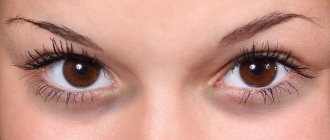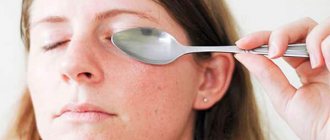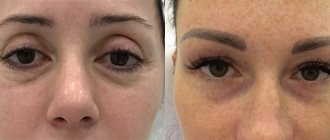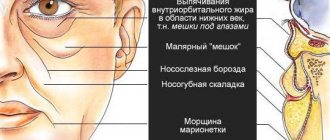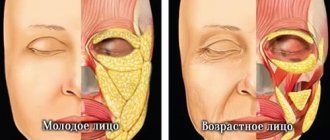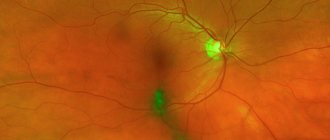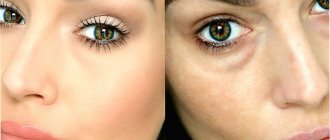Parents are always worried about the health of their children, especially if they notice that the baby is not all right in appearance and there are bruises or deep blue-violet shadows under the eyes. Such complaints are very common among parents, and doctors have to meet such children almost every day in practice.
But the presence of bruises under the eyes is not a very good sign, and those parents who go to the doctor with this complaint do the right thing, since such manifestations are often associated with problems in the child’s health. Then it is necessary to quickly understand the problem and determine why these bruises occur and whether the child needs to be treated, or is this a harmless phenomenon? Let's try to understand all the reasons that cause bruises under the eyes.
Why face?
As you know, the face and eyes are not only a mirror of the soul, but also a mirror of the health of the child’s body. The skin and mucous membranes of children quite reliably tell the doctor about the general condition of the body and various problems in it. The face reacts sensitively to changes in internal balance and metabolism, losing its freshness and giving alarm signals. Therefore, attentive mother and father immediately note alarming signals that something wrong is happening in the baby’s body.
One of the most visually noticeable signs of trouble can be the blueness of the skin under the eyes. For the most part, this occurs due to the fact that the skin in the eye area becomes thinner, and the skin vessels underneath begin to show through. Much less often, bruises under the eyes occur due to the fact that small or rather large hemorrhages form there. And the first step is to determine the exact cause of circles or bruises under the eyes.
Parents themselves cannot always determine this; then the help of a pediatrician or other specialists is needed. However, parents themselves should roughly guess why circles or bruises appear under the eyes in order to help the doctor analyze the reasons and indicate important facts. Why might these manifestations occur?
Bruises under the eyes of a baby
In the first year of life, bruises in the eye area of a child may appear against the background of a deficiency of vitamins or iron in the body (for example, with defective breast milk), due to disrupted wakefulness and sleep patterns, against the background of the development of serious systemic disorders and pathologies. It is imperative to undergo a comprehensive examination, identify the causes causing the symptom, and obtain recommendations on nutrition and daily routine from a pediatrician.
Factor two – increased fatigue
Sometimes bruises under the eyes appear in children of school age, and then parents immediately begin to suspect that the child is very tired at school or during additional activities at school (attending clubs, sections). Today's children are enormously overloaded - the school curriculum itself is significantly different from what it was even in our time, it can quite tire not only children, but also parents who are trying to help their children with homework.
In addition, the volume of workload both at school and at home sometimes exceeds all reasonable limits; the child sometimes has no time to really rest after school, since a very large amount of homework still needs to be completed. Therefore, children are overloaded, tired and cannot fully rest. Parents themselves largely contribute to overwork by additionally enrolling their children in various sections, studios and extra classes.
And modern children are also seriously influenced by the computer and TV. If previously, after school, children went outside to kick a ball and run, today, more and more often, they spend their free time watching TV or computer games and the Internet. This rhythm of life for children is not the most optimal, and can greatly affect the structure of the skin and the functioning of blood vessels. The skin on the face becomes thinner, the vessels under it begin to become more visible. As a result, visually it appears as dark circles and shadows around the eyes.
First of all, the fight against dark circles under the eyes should begin with organizing the correct daily routine and maximum adherence to a shift between work and rational rest. If possible, remove the child from the additional sections. Especially those that the child does not have much enthusiasm for, replace them with walks (but not sitting at the computer and playing games).
Causes of bruises under the eyes in children
The main reasons for the appearance of circles under the eyes of a child:
- Anemia. A common reason is when a child’s body lacks vitamins and iron, the baby’s appearance deteriorates. The face becomes pale, and the blood vessels are clearly visible through the thin layers of the skin. When there is insufficiency of iron in the body, the epidermis begins to dry out and the skin defect becomes more pronounced. The circles under the eyes become dark purple, almost black.
- Allergy. It occurs on pets, plant pollen and food; reddish spots appear under the eyes, in the nasolabial folds, on the cheeks and wings of the nose. Contact your doctor and he will prescribe treatment for you.
- Helminthiasis. In preschool age and among primary schoolchildren, there is a problem of worms. Worm infestation is accompanied by symptoms: bruises under the child’s eyes turn brownish, pain in the navel, teeth grinding at night, weight loss with increased or decreased appetite. The child has bruises under the eyes, has restless sleep, and becomes moody, lethargic, or overexcited.
- Genetic factor. Why do children have bruises under their eyes? The blue color under the eyes can be noticeable from birth, the reason for this is thin skin, through which the capillaries are clearly visible. The blood vessels in some newborns are located close to the top layer of skin. The genes are not corrected and this phenomenon will remain in the child. You will need to contact a dermatologist so that he can prescribe a special composition for the care of delicate skin.
- Vegetovascular dystonia. Causes the appearance of circles under the eyes and is accompanied by symptoms: headaches, dizziness, pale skin, intolerance to stuffiness, weakness and fatigue.
- Sedentary lifestyle. This problem occurs mainly among schoolchildren. He spends a lot of time at school, then does homework and sits at the computer in his free time. There is no time left for walking and he receives less oxygen, the skin begins to thin and turn pale. After some time, bruises begin to appear under the eyes, the child looks tired, and begins to develop apathy and lethargy.
- Overwork. This happens after the summer holidays for schoolchildren; blue circles appear under their eyes. For students, the beginning of the school year is stressful, and this does not depend on the child’s age and class; an adaptation period is still needed. Organize the correct daily routine, especially for a weak child; in addition to studies and extracurricular activities, he should have enough time for rest and entertainment.
- Kidney problems. The disease is accompanied by the following symptoms: bruises appear under the child’s eyes, pain in the lumbar region, and often the need to go to the toilet. In the morning, there is swelling of the eyelids, and the urine sometimes becomes cloudy. With such problems, you need to contact a nephrologist; after an examination, he will prescribe medication and a special diet.
- Injuries to the eyes, nose, head. During active games, children fall from horizontal bars, slides, and bicycles. Schoolchildren can get hit on the head with a ball while playing football; problems are not immediately identified if there are no wounds or blood loss. There may be bruising under the eyes, swelling, or a visible mark from the blow under one eye. You will need to visit a pediatric neurologist or traumatologist to rule out a concussion or a fracture of the nasal bones.
- Chronic tonsillitis and immunodeficiency. Associated symptoms: yellow or white coating on the tongue, pain when swallowing, lump in the throat, frequent exacerbations of diseases, possible fever. It may occur after a recent infectious disease that weakens the immune system.
If your child suddenly feels ill, becomes pale, has chest pain , has bruises under his eyes and becomes weak, call an ambulance immediately. These symptoms occur with heart problems.
Bruises under the eyes of a baby
One of the reasons for negative symptoms is the appearance of dark circles under the eyes of a newborn. You need to contact your pediatrician for an examination. In the first weeks of life, such symptoms may occur due to weak immunity or imperfections in the digestive and urinary systems. To prevent bruises under your baby’s eyes, you need to take preventive measures:
Factor three - poor nutrition
Nowadays, few people can boast that their children eat absolutely correctly, and even if at home they eat healthy cereals and soups, compassionate grandmothers stuff their kids with sweets, and friends on the street treat them to chips and soda. In addition, the dominance of fast food at every turn beckons a child to try something new and tasty, but not at all beneficial for his digestion and health in general.
At school age, it is generally difficult to control a child’s nutrition, but he may not eat at school or buy in the school buffet not exactly the foods that will be healthy for him.
In addition, in an attempt to feed an unwilling child who refuses to eat or eats very poorly, parents follow his lead, buying those foods that he agrees to eat. In addition, busy parents sometimes have no time to prepare full meals, and they resort to semi-finished or instant meals. Which only need to be warmed up. Also in children's nutrition.
Especially in the winter-spring period, there are few fruits and vegetables, if any. There may be little benefit in them, since they were stored incorrectly or dishes prepared from them lose most of the nutrients.
Factor four – disturbances in the daily routine.
For the body to function properly, it is necessary to maintain a clear daily routine, adequate sleep and sufficient rest, physical activity and exercise. If a child is constantly lacking sleep, the body's compensation mechanisms are gradually depleted; the first sign of overwork may be bruises under the eyes and general lethargy.
To prevent bruises from appearing, it is necessary to normalize the child’s sleep; up to ten years of age, sleep should take at least 9-10 hours a day, it is important to put the child to bed at the same time, in addition, it is important to sleep during the day. In addition to the duration, the quality of sleep itself is also important - you should not play active games with your baby before bed or watch TV for a long time. It's good to take a walk before bed. Ventilate the room, monitor the temperature and humidity in the nursery.
Read also: Secrets of a speech therapist: 15 tasks for the correct formation of a child’s speech
The fifth factor is the development of anemia.
One of the problems with the formation of circles under the eyes is iron deficiency anemia. Lack of iron first of all. It affects the condition of the skin, bruises under the eyes may occur due to thinning and dry skin, and they can appear long before changes in the blood test and are a sign of hidden iron deficiency.
If bruises appear and become pronounced, all examination activities begin with a blood test and exclusion of anemia. Anemia is especially dangerous for infants; in them it can lead to eating and growth disorders.
Even if the analysis shows no anemia, and the circles under the child’s eyes are quite stable, it is necessary to carefully monitor the baby and monitor hemoglobin, since anemia can exist for quite a long time as a latent iron deficiency. Then the body tries to compensate for the shortage from reserves, but gradually the reserves are depleted.
In this case, you need to adjust the child’s menu to include meat and meat products. Rich in iron, as well as vitamins and minerals that help the absorption of this mineral are buckwheat, liver, apples and juices. If iron deficiency is detected, drug treatment with iron supplements is necessary.
Causes of bruises under the eyes in children
A number of factors can contribute to the appearance of circles or swollen bruises around the eyes of a child. Disturbed daily routine, lack of sleep and a large amount of time spent at the computer or in front of the TV, poor unbalanced diet and impaired drinking regime are easily correctable causes, the elimination of which not only leads to the disappearance of bruises around the eyes, but also helps to improve the general state of his health. . In some cases, a change in skin color indicates the following pathological disorders:
- helminthiasis (parasitic infection);
- iron deficiency anemia (insufficient levels of iron in the blood);
- kidney disease;
- endocrine diseases;
- diabetes;
- weakening of the immune system.
Genetic predisposition
Sometimes blue circles around the eyes are an appearance trait, a hereditary trait through one of the parents. It is typical for people with fair hair, deep-set eyes, and sensitive, thin skin from birth. Blood vessels that come close to the surface of the skin can also create a bruising effect. These cases should not cause concern; over time, the color of the skin around the eyes may normalize as facial features change due to the growth of the cranial bones.
Violation of the daily routine
Often the child is pale and has bruises under the eyes due to excessive fatigue and a disrupted daily routine. Overwork and chronic lack of sleep occur against the background of increased mental or physical stress, when going to bed and waking up in the morning occur at different times, daytime sleep is not regulated, and time for watching cartoons and computer games is not limited. Normalizing the baby’s sleep, work and rest schedule is the first point that parents should pay attention to if they discover blueness in the child’s lower eyelids.
Poor nutrition
Bruises under the eyes of a teenager or a child of preschool or primary school age can indicate not only increased fatigue, but also metabolic disorders due to an unbalanced diet. Darkening of the skin is caused by low-quality foods, unhealthy dishes with a large number of preservatives, additives (including fast food), calcium deficiency, vitamins B, A, D, E. A blood test helps to identify such malfunctions, after which you need to consult with a specialist to develop a balanced diet, including:
- full breakfasts, lunches and dinners;
- more vitamin-rich vegetables and fruits;
- Having healthy snacks between main meals.
Violation of the water-salt balance can also cause bruises. The lack of fluid in the body is easily eliminated when the child drinks more plain water. The minimum is calculated using the formula “weight * 30”, for example, for a child weighing 25 kg, the minimum amount of liquid drunk per day is 750 ml. It is advisable to completely exclude carbonated sweet drinks, give preference to plain clean water, natural compotes and fruit drinks, and weak tea.
Iron-deficiency anemia
Bruises and bags under the eyes of a child can be a symptom of iron deficiency anemia, especially in infancy (up to a year). A lack of hemoglobin can cause a purple tint to the skin around the eyes, pale skin, weakness and dizziness, and tachycardia. Iron deficiency can be determined using a blood test; a special diet (enhanced nutrition) is recommended as treatment.
Kidney diseases
Pathological processes due to circulatory disorders, malfunctions of the lymphatic and urinary systems can cause blueness in the child’s eyes. The first organ examined is the kidneys - ultrasound, general urine and blood tests are prescribed. Additional signs of kidney disease are morning swelling of the face, the formation of “bags” (edema), pain in the lumbar region, and frequent urination. If this set of symptoms appears, you can consult a nephrologist.
Helminthiasis
Bruises under the eyes of a child may be evidence of a parasitic infection, a consequence of the release of toxic waste products by helminths, their entry into the baby’s blood and the development of general systemic intoxication. In this case, additional symptoms are anemia (low hemoglobin level), changes in appetite (increased or absent), weight loss, headaches, itching in the perineal area. If you suspect helminthiasis, you must take blood and stool tests and consult a doctor to select a parasite removal regimen.
Endocrine pathologies
In addition to kidney disease, bruising can be caused by hormonal disorders and diseases of the endocrine system. Disorders of the functions of the thyroid gland, adrenal glands and pancreas provoke disruptions in the production and transport of hormones to the tissues and cells of the body, and changes in their metabolism. If other symptoms (neurological, metabolic or somatic) appear, you need to show the child to an endocrinologist.
Factor six – helminths.
Sometimes the causes of the development of circles under the eyes are helminths in the body (infection with worms). At the same time, worms have a general negative effect on the body and poison both the intestines and the entire body of the child, while they also eat up their owner in terms of nutrients. And due to the irritating and toxic effects of worms, the body cannot fully absorb the remaining vitamins and minerals. With helminthic infestations, children complain of pain in the navel area. Abnormal bowel movements and dark circles under the eyes.
Parasites can be identified by a stool test for worm eggs or a blood test for antibodies to parasites.
Elimination of bruises under the eyes in children
In order to eliminate them, it is important to know why they occurred. After this, first of all, etiological therapy (that is, affecting the cause) is prescribed.
Prevention
Preventive measures include prescribing:
- normalization of sleep and wakefulness;
- walks in the fresh air;
- proper nutrition;
- timely completion of medical examinations;
- playing sports or physical education;
- complex of vitamins and microelements in the autumn-spring period.
